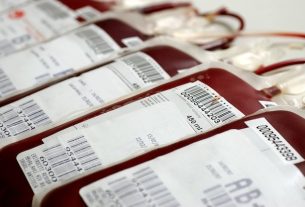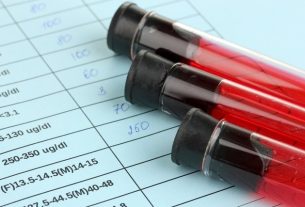Anemia is a disease in which the amount of hemoglobin within red blood cells is altered, causing symptoms such as weakness, lack of appetite, pale skin and eyes, and memory loss.
Anemia can be caused by poor diet, genetic changes, use of certain medications or situations that reduce the absorption of nutrients, such as celiac disease and bariatric surgery, for example. Learn about the main causes of anemia.
If anemia is suspected, it is important to consult a general practitioner or hematologist, to confirm the diagnosis and initiate the most appropriate treatment, which varies depending on its cause, and may include improving eating habits, injection, use of supplements or blood transfusion, in some cases.

Anemia symptoms
The main symptoms of anemia include:
- Weakness;
- Tiredness;
- White gums;
- Paleness of the skin, lips and eyes;
- Dizziness;
- Shortness of breath during physical exertion;
- Lack of appetite.
In addition, people with anemia may also experience headaches, memory loss and mouth sores. See other symptoms of anemia.
The symptoms of anemia vary depending on the cause of the condition, the degree of anemia, the person’s age and health status.
Online symptom test
If you think you may have anemia, select the following symptoms to find out your risk:
This symptom test is only a guidance tool and, therefore, does not serve as a diagnosis or replace a consultation with a doctor.
How to confirm the diagnosis
The diagnosis of anemia must be made by a hematologist or a general practitioner, through evaluation of the signs and symptoms presented by the person.
To confirm the diagnosis, the doctor must also request a blood count to assess the amount of hemoglobin, MCV, HCM, serum iron, ferritin, vitamin B12 and folic acid.
Make an appointment with the nearest hematologist to evaluate the possibility of anemia:
Taking care of your health has never been easier!
In addition, the doctor may also request, in some cases, genetic tests, biopsy or imaging tests, such as endoscopy and MRI to investigate the cause of the anemia. See the tests used to confirm anemia.
Types of anemia
Anemia can be classified into 3 main types according to the characteristics of the red blood cells:
1. Macrocytic anemia
In this type of anemia, the size of the red blood cells is increased, which can be verified by the Mean Corpuscular Volume (MCV) value above 100 fl.
The main types of macrocytic anemia are:
- Megaloblastic anemia: It occurs due to a lack of vitamin B12 or folic acid, or the use of some medications, which can cause tiredness, hair loss or loss of appetite. Understand better about megaloblastic anemia;
- Pernicious anemia: is an autoimmune disease where the body is unable to absorb vitamin B12, due to a deficiency of intrinsic factor, which is a protein that promotes the absorption of vitamin B12 in the body.
Fanconi anemia is a genetic disease that causes signs and symptoms such as changes in the bones, spots on the skin and short stature. Know all the symptoms of Fanconi anemia.
2. Microcytic anemia
Microcytic anemia is characterized by a decrease in the red color and size of red blood cells.
The main types of microcytic anemia are iron deficiency anemia, which is caused by a lack of iron in the body, and thalassemia, which is a hereditary disease characterized by defects in the production of hemoglobin. Check out the main types of anemia.
3. Normocytic anemia
Normocytic anemia is characterized by changes in the bone marrow that can lead to changes in the shape of red blood cells or accelerate their destruction, despite the red blood cells being normal in size. The main types of normocytic anemia are:
- Sickle cell anemia: It is a hereditary disease that causes changes in the shape of red blood cells, causing symptoms such as bone pain, growth retardation, yellow eyes and skin. Learn more about sickle cell anemia;
- Hemolytic anemia: is a type of anemia in which antibodies destroy red blood cells, causing symptoms such as tiredness, rapid heartbeat, dark urine and paleness.
Aplastic anemia is a type of bone marrow alteration characterized by a decrease in the number of red blood cells, leukocytes and platelets in the blood.
This condition can be genetically inherited or related to the use of medications, for example. Understand better about aplastic anemia.
Possible causes
The main causes of anemia are:
- Low intake or increased needs for iron, vitamin B12 or folic acid;
- Use of some medications, such as allopurinol, methotrexate, fluorouracil and azathioprine;
- Genetic diseases;
- Heavy menstruation or bleeding;
- Conditions that increase antibodies that destroy red blood cells, such as lupus, rheumatoid arthritis, or leukemia.
Furthermore, anemia can also be caused by situations that reduce the absorption of nutrients, such as celiac disease, bariatric surgery, excessive consumption of alcoholic beverages and hemodialysis.
Read too: 7 main causes of anemia (and what to do)
How the treatment is carried out
Anemia treatment must be carried out under the guidance of a general practitioner or hematologist and varies depending on the cause and type of this condition, including the use of medicines, oral supplements, injections, blood transfusions, bone marrow transplants and nutrition.
- Medicines: corticosteroids, antibiotics, immunomodulators and anti-inflammatories may be recommended for the treatment of some types of anemia. See when to take medicine for anemia;
- Oral supplements: iron, vitamin B12 and folic acid supplements may be prescribed for the treatment of iron deficiency anemia, thalassemia and megaloblastic anemia;
- Injection: injections of iron or vitamin B12 may be indicated mainly in cases of profound anemia or pernicious anemia;
- Blood transfusion: is recommended for people with severe anemia, or who have hemolytic anemia, sickle cell anemia, thalassemia or Fanconi anemia;
- Bone marrow transplant: It is a treatment similar to blood transfusion, being indicated for the treatment of thalassemia and Fanconi anemia, for example.
Depending on the type of anemia, the doctor or nutritionist may also recommend the intake of foods rich in iron, such as liver, chicken, fish, pumpkin seeds and chickpeas, and sources of vitamin C, such as cashews, acerola , guava, strawberry and kiwi. See what the diet should be like in cases of anemia.
Read too: Natural treatment for Anemia
Possible complications
When left untreated, anemia can increase the risk of some complications, such as:
- Cardiovascular changes, such as arrhythmia, heart attack and heart failure;
- Problems in pregnancy, such as premature birth, low birth weight babies or increased blood loss during birth;
- Delays in physical and mental development in children;
- Restless legs syndrome.
Furthermore, untreated anemia can increase the risk of many organ failures, which can cause death.
Read too: 9 common questions about anemia
share the information
Bibliography
- CASCIO, Michael J; DELOUGHERY, Thomas G. Anemia: Evaluation and Diagnostic Tests. . . . North Am Clin Med. Vol.101, n.2. pp. 263–284,
- TREASURE ISLAND (FL): STATPEARLS PUBLISHING. Fanconi Anemia. Available at: <https://www.ncbi.nlm.nih.gov/books/NBK559133/>. Accessed on 26 Dec 2022
- TREASURE ISLAND (FL): STATPEARLS PUBLISHING. Sickle Cell Anemia. Available at: <https://www.ncbi.nlm.nih.gov/books/NBK482164/>. Accessed on 26 Dec 2022
- TREASURE ISLAND (FL): STATPEARLS PUBLISHING. Hemolytic Anemia. Available at: <https://www.ncbi.nlm.nih.gov/books/NBK558904/>. Accessed on 26 Dec 2022
- TREASURE ISLAND (FL): STATPEARLS PUBLISHING. Aplastic Anemia. Available at: <https://www.ncbi.nlm.nih.gov/books/NBK534212/>. Accessed on 26 Dec 2022
- TREASURE ISLAND (FL): STATPEARLS PUBLISHING. Anemia. Available at: <https://www.ncbi.nlm.nih.gov/books/NBK499994/>. Accessed on 26 Dec 2022
- TREASURE ISLAND (FL): STATPEARLS PUBLISHING. Megaloblastic Anemia. Available at: <https://www.ncbi.nlm.nih.gov/books/NBK537254/>. Accessed on 26 Dec 2022
- TREASURE ISLAND (FL): STATPEARLS PUBLISHIN. Pernicious Anemia. Available at: <https://www.ncbi.nlm.nih.gov/books/NBK540989/>. Accessed on 26 Dec 2022

Sign up for our newsletter and stay up to date with exclusive news
that can transform your routine!
Warning: Undefined array key "title" in /home/storelat/public_html/wp-content/plugins/link-whisper-premium/templates/frontend/related-posts.php on line 12
Warning: Undefined array key "title_tag" in /home/storelat/public_html/wp-content/plugins/link-whisper-premium/templates/frontend/related-posts.php on line 13



